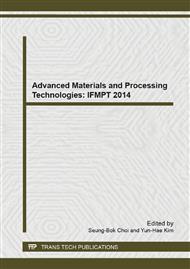p.251
p.256
p.260
p.267
p.275
p.279
p.285
p.289
p.293
Hydrophilic Mechanism of Sunflower Leaves and Simulation Research
Abstract:
This paper studied wettability of sunflower leaves, contact angle of sunflower leaves were measured through the contact angle measuring instrument, which was 43.6°. Microstructure of sunflower leaves were observed by scanning electron microscopy, It found that sunflower leaves is micro and nanostructures covered some needle-like spikes, this feature has an important influence on its hydrophilicity. Through Matlab software hydrophilic mechanism of sunflower leaves was carried out the simulation study, roughness factor γ and area ratio plays an important role to its wettability, which can increase hydrophilicity of the solid surface.
Info:
Periodical:
Pages:
275-278
Citation:
Online since:
February 2014
Authors:
Keywords:
Price:
Сopyright:
© 2014 Trans Tech Publications Ltd. All Rights Reserved
Share:
Citation:


